The First Black Models And Paco Rabanne

The first black model to appear on the cover of a major fashion magazine was the ethereal, other-worldly, Donyale Luna. When her picture appeared on the cover of Harper's Bazaar and Vogue in 1965, she indirectly inspired a handful of other young U.S. black models to head to Paris to work in high fashion. Among these was Sandi Collins, one of the first black models to ever walk the runway in Paris and a person who has since gone unrecognized in any history of black models from that era.
Here now, in her first-ever interview, Sandi Collins recounts her experiences and memories of modeling for Paco Rabanne, the rebellious 60s fashion designer known for dressing Brigitte Bardot and Barbarella. Paco Rabanne is best known as a provocateur of the French fashion establishment who created avant-garde metal clothing and purses 'Le 1969' -- the lodestar for our metallic purses and clothing. What is less known about Rabanne is that he also provoked the U.S. fashion industry by including black fashion models in his shows.
The First Black Supermodel, Donyale Luna
Escama: So the year is 1966, you’re in Paris, the center of 60s mod fashion and you’re working with Paco Rabanne and André Courréges, two of the most avant garde fashion designers at that time. How did you end up there?
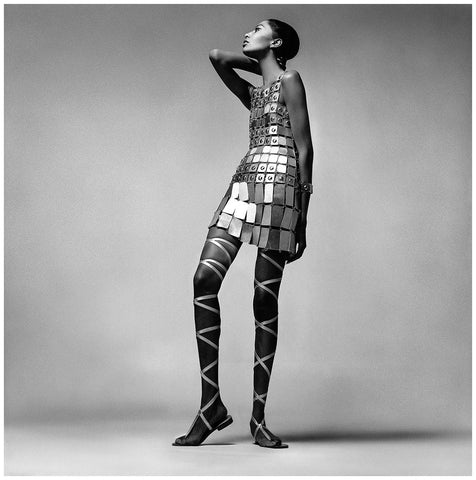 Donyale Luna in Paco Rabanne, Dec.1966 Photo Richard Avedon
Donyale Luna in Paco Rabanne, Dec.1966 Photo Richard Avedon
Sandi: In the sixties a popular publication at the time was Look Magazine. Donyale Luna -- who happened to become the first black model featured on the cover of Vogue in 1966 -- was featured in Look Magazine. I read the feature and was intrigued; it mentioned that Donyale worked in Paris, France. Several months later I made the decision to also go to Paris to become a model. I arrived with $30, no connections and couldn’t speak the language. But with some determination (and perhaps some divine intervention), I was able to land a contract with a German-based modeling agency who signed me on as a model for Courréges and also landed me several shows for Paco Rabanne.
 Sandi Collins: '12 Unwearable Dresses in Contemporary Materials'
Sandi Collins: '12 Unwearable Dresses in Contemporary Materials'
12 Unwearable Dresses in Contemporary Materials
Escama: You were in Paco Rabanne’s ground breaking show in 1966 called “12 Unwearable Dresses in Contemporary Materials.” It was labeled 'space age fashion' and it got a lot of attention, not all of it favorable. Do you have any memories of the show or of the shocked reaction from the fashion press?
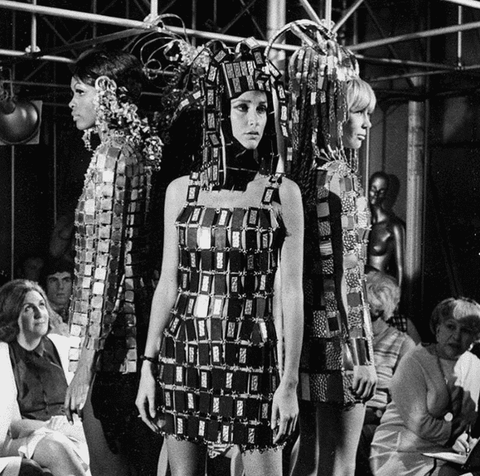
Sandi Collins (left)
Sandi: I was 23 at the time and my mind frame very much was that this is a business. The couturiers made it apparent that time was money and there was no concern for even the name of the show. As a model I was there to showcase the designs, walk the runway and then get to the next show. In Europe at the time, it was easy for a well-liked model to have multiple shows or photo shoots within a day for major designers. We were on a very fast paced schedule. The critique of the clothes, or whether the collection was well received was not at the top of the list of priorities because you are frequenting so many fashion houses. I tended to stay neutral to the fashion and really enjoyed the nature of the work itself.

Escama: Just out of curiosity, how were the Paco Rabanne dresses? Were they heavy?
Sandi: All of the dresses were very well made. The metal dresses however stood out to me as being very cold and somewhat heavy. The plastic dresses were much lighter and fun, as well as being well tailored to the body.
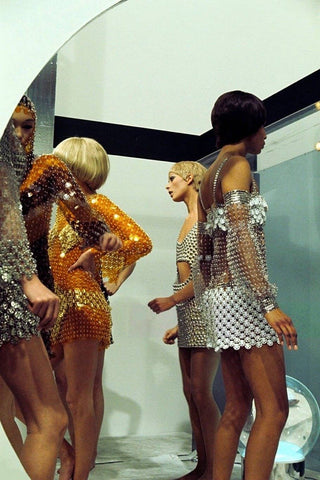 Paco Rabanne Space Age Fashion, mid 1960s
Paco Rabanne Space Age Fashion, mid 1960s
Paris Welcomes First Black Models
Escama: As a young African American model in Paris, how did it feel to be part of this creative environment in the 1960s Paris fashion scene?
Sandi: I think because I was so fresh to the industry, I was unaware that we were making history. When I was received into the Paris fashion scene it was such a stark contrast to the political unrest occurring in the United States. Paris was very artistic and welcoming, France allowed me to be recognized as beautiful. I was able to walk down the street and be seen as a human and not a color, perhaps for the first time in my life. That was very important to me for my growth as an individual. I was able to be featured in countless fashion shows, including Paris Fashion Week several times, and went on to pose and be published in multiple publications including Elle, Vogue, Marie Claire and L’Official.
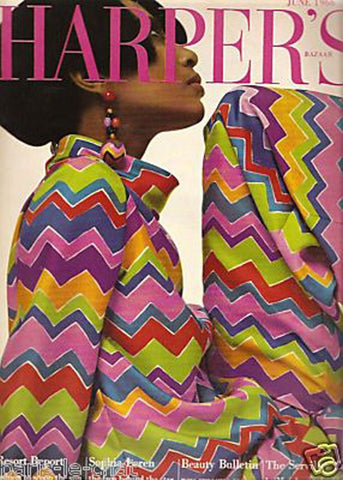 Donyale Luna Harper's Bazaar
Donyale Luna Harper's Bazaar
Racism in U.S. Fashion Press
Escama: Did you encounter racism from the American fashion press in Paris? Donyale Luna was featured in Harper's Bazaar in 1966 and was banned from appearing again in the magazine after advertisers in southern states pulled their advertising. In 1964 Paco Rabanne sent a black model for the first time down the runway, in a wedding dress made of white plastic. According to Barbara Summer's, Skin Deep: Inside the World of Black Fashion Models in America and Abroad, he was quoted as saying that backstage after the show:
‘I watched them coming’, ‘the girls from American Vogue and Harper’s Bazaar. “Why did you do that?” “You don’t have the right to do that, to take those kind of girls. Fashion is for us, white people” They spat in my face. I had to wipe it off.’'
Sandi: I was not there for the show that you mention. I had no idea that as a designer Paco Rabanne ever encountered this. I did not arrive in Paris until 1966. It's difficult to imagine a man with such a lovely spirit having to endure such ignorance. I love his bravery and his creativity.
What I distinctly remember was during the fashion shows in Paris the American press would turn their cameras away when I would appear on the cat walk. This was done repeatedly during my time in fashion in Europe and only by the American press.
 Paco Rabanne Atelier Paris
Paco Rabanne Atelier Paris
Escama: How was it working with Paco Rabanne the man? Do you have memories of his personal style or the way that he interacted with people in general?
Sandi: I love Paco Rabanne as an individual. Working with him, from what I recall was that he was intensely calm and always a pleasure to work with. We did several shows together and it was an amazing experience that I will always cherish.
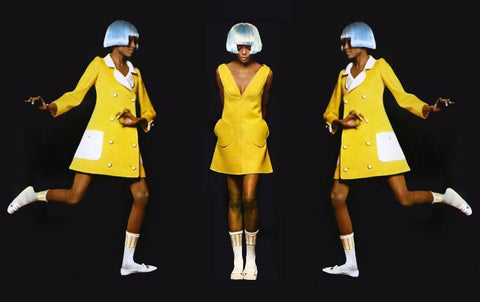 Sandi Collins wearing Courréges. Photo by Helmut Newton for French Elle. (She's frequently incorrectly identified in this photo as Diana Ross)
Sandi Collins wearing Courréges. Photo by Helmut Newton for French Elle. (She's frequently incorrectly identified in this photo as Diana Ross)
One Of The First Black Models
Escama: As a black fashion model in 1966 -- along with Donyale Luna -- your career predates many of the later famous black models such as Pat Cleveland. Do you feel that you've been sufficiently recognized as one of the first black models in couture?
Sandi: I have not been given any recognition as one of the first American Black models in Paris Fashion Couture. There was a book that was published a few decades ago and there was no mention of me. I cannot recall the name of the book but it was about the history of Black models or models of color. As you have seen I am listed as Diana Ross online. It is flattering, but it would be nice to have been recognized for the barriers that I crossed as myself. That said, I am quite content in my life.
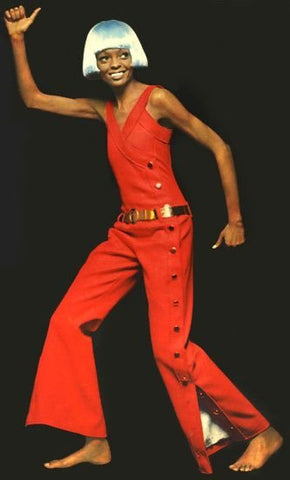 Sandi Collins photo by Helmut Newton
Sandi Collins photo by Helmut Newton
Rising Above The Competition
Escama: Did you ever meet Donyale Luna? Among this 'first wave' of African American models in Paris in the mid 1960s was there a sense of solidarity or was the environment competitive?
Sandi: Donyale Luna was very popular, appearing in movies by the time I arrived in Paris in '66. I never met her. At the time there were two Black models in Paris, Donyale Luna and a girl named Kelly. Kelly, I was told was related to the owners of the Pittsburgh Courier. I was given her number and reached out to her people. I told them that I was a new model in Paris and asked if they would possibly consider helping me to learn how to apply my make-up for the shows. I was informed by her people that it would be a definite 'no', they were not going to help me apply my make-up!! (laughing). So, for me I could say that the environment was very competitive among the very few Black models that existed at the time. I was primarily embraced by the Jewish community of Paris which in turn became an internal revelation of who I was not in color but in spirit and I am very grateful for those ties that bind.
 Sandi Collins, cover of L'Officiel magazine 1970
Sandi Collins, cover of L'Officiel magazine 1970Escama: Do you still model? And if not, would you ever consider it again?
Sandi: I am 77 years of age and have not modeled in decades, maybe once I can get the hang of how to take a selfie I may reconsider it!
Special Thanks:
The inspiration for this interview came from the daughter of Sandi Collins, Jade Lillie. It was Jade’s comment at the bottom of our Paco Rabanne blog post that brought Sandi Collins to my attention. (My mother is the model on the far left side in the second and third photos. Thank you so much for sharing the amazing work they accomplished!!!).
Over the course of a month, Jade and I collaborated on the development of the interview questions. Jade ultimately conducted the interview with her mother by phone and transcribed Sandi’s responses. We enjoyed getting to know Sandi through this interview process and we hope you enjoy reading the blog as much as we enjoyed writing it.
- Andy Krumholz
Some interesting articles for further reading:
Jean Paul Gaultier on France's Fashion Rebels
Black Beauty & Fashion | Donyale Luna
Trailblazers: Black Models That Changed The Fashion Industry
Runway racism clouds Paris Fashion Shows
African American experiences in Paris, Maison Noire


Fabulous! Thank you, Sandi Collins for being a trail blazer! I love your work! Brava💖👏👏
Thanks for this article ..and to model Debra Shaw for sharing it on artist & designer Mikel Kigour’s Facebook post!! 💞💞💞
Carol .. co-founder of Babylone bis Resturant in Paris 2em… and fashion model in Paris from April 1978 .. ditto re un-named photo/no bio in “Skin Deep …”!!
Thank you si much for being such an inspiration and for opening thé way for us, it has been a fight to work in modelling and Acting industry in France but step by step we let only Talent and Beauty express themselves ❤️
THANK YOU so much for this. Over the years I’ve been doing a lot of research on the trailblazing Black models of the ’50s and ’60s and not once have I ever heard Sandi Collins name mentioned. I have always wondered who was the Black model in Courreges fashion videos and now I know.
Truly admirable.
Good morning:
Thanks for the history lesson!
I’m so saddened for what my people experienced and is still experiencing.
My email is JOYEATRIGHT is because I’m a Registered Dietitian!
Have a safe, productive and blessed weekend.
Sincerely,
Joycelyn K.Valentine
Leave a comment